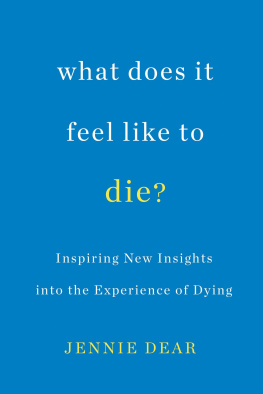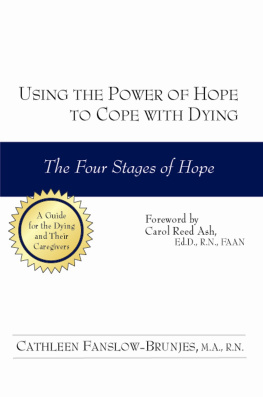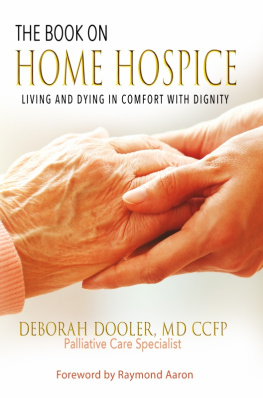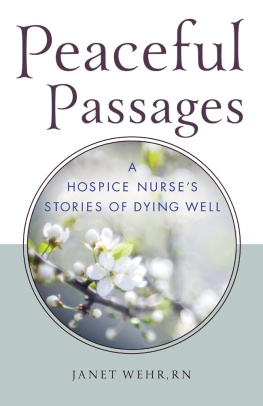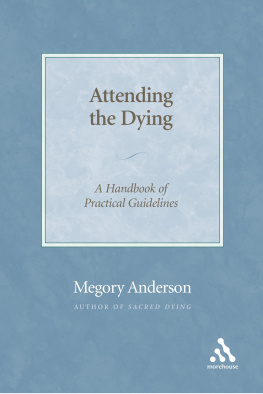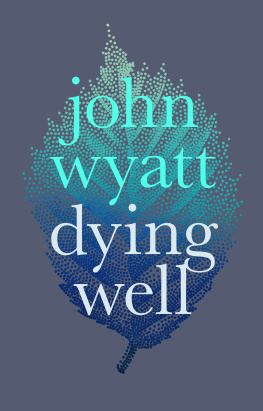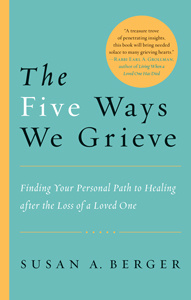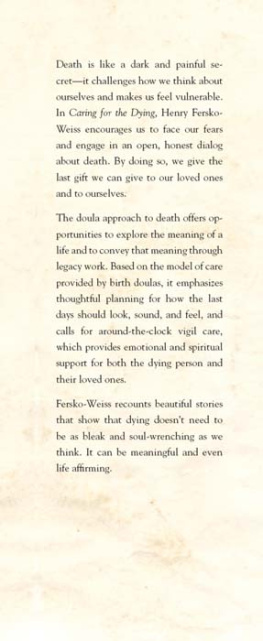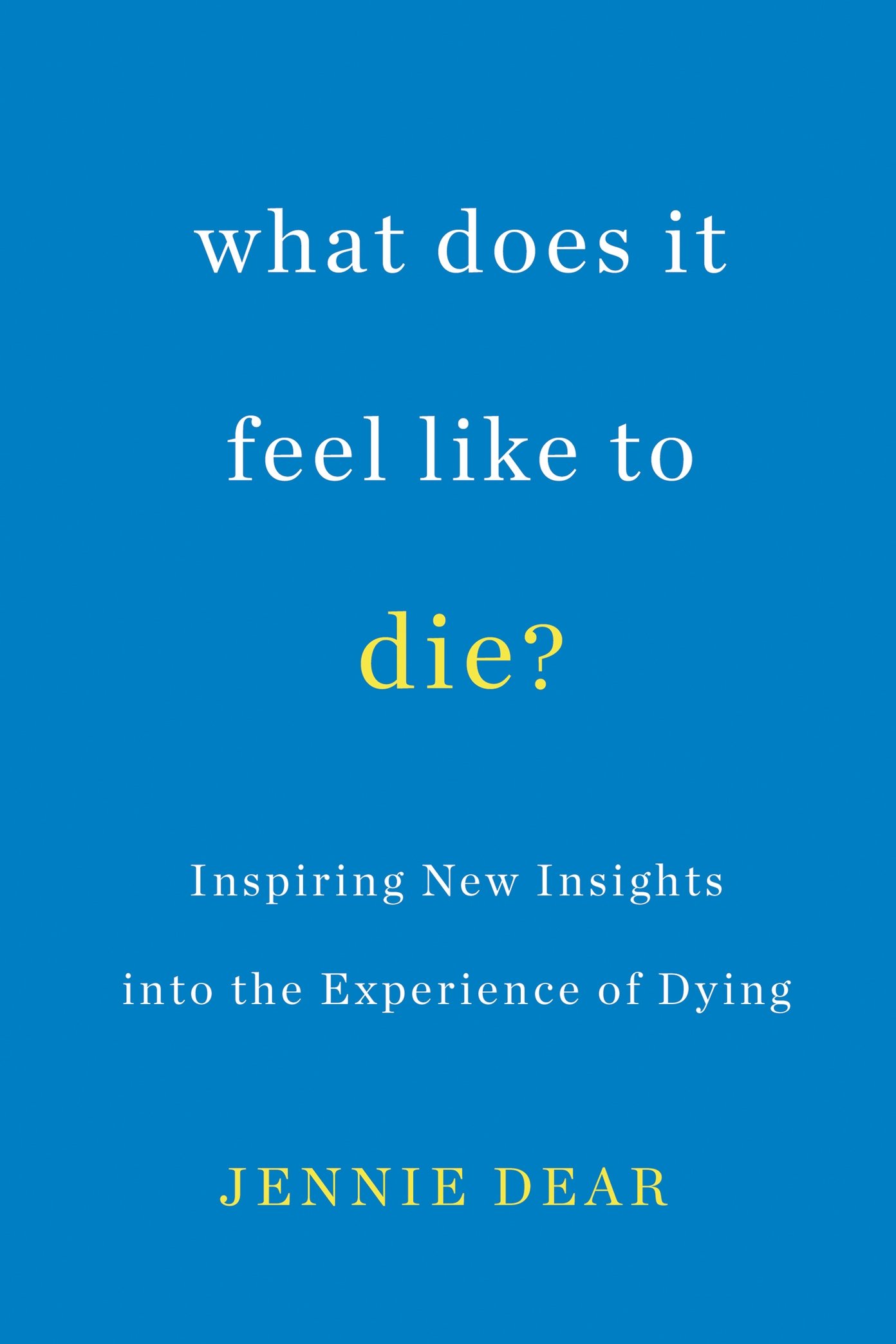acknowledgments
A few people who work with the dying have told me they no longer fear their own deaths. I dont know whether thats true for me; I do know these are professionals whom I would trustwill trustas Im dying. They are an exceptionally caring group.
At each stage of this project, there have been people who took a leap of faith to help it along the way.
Thanks to Pat Amthor, the Durango hospice nurse, for her frankness so many years ago about my mothers dying process. Thanks to David Hui, one of the first people I interviewed for this book, for his patience; to Margaret Campbell, who was so encouraging as I first began my research, and to Virginia Lee at McGill University, Cline Glinas, David Hovda, and Nessa Coyleall wonderful scholars whose care and thoroughness have been inspiring.
Thanks to Paul Bisceglio at The Atlantic.com, who recognized early on the importance of the subject and whose editing has been so consistently skillful. Thanks to my agent, Jane Dystel, and her associate agent, Miriam Goderich, without whom this book might not have seen the light of day. Thanks to the sensitive editing of Denise Silvestro at Kensington.
Thanks to Faron Scott, with whom I first learned about writing and publishing a book. Ill always be grateful for our friendship.
Thanks to Mac Johnson in Durango for his generosity in speaking with me when his wife was dying.
Thanks to Joan Teno and Joanne Lynn, who study systemic trends and thereby help not just individuals but thousands of people.
Thanks to James Hallenbeck and Lonny Shavelson, who each set aside significant portions of a day to explain their work to me. Thanks to Scott Podolsky and David S. Jones, both of whom showed an especially delightful intellectual enthusiasm.
Thanks to Gary Rodin, Harvey Chochinov, and James Bernat for the amount of time and care they took in interpreting their research for me. Thanks to Kevin Nelson, who left a meeting early in order to patiently answer my questions on a busy day.
Thanks to Ira Byock, who has written his own wonderful books about dying, for being so generous with his time and expertise.
Thanks to Peter Rogatz, Laurie Leonard, Fred Schwartz, Judith Schwarz, Sue Dessayer Porter, Terry Law, and Barbara Sarah, all of whom have done so much to help dying people.
Thanks to Emery Brown at Harvard University, and to Jeremy Brown at the National Institutes of Health. Thanks to Marian Grant and Nick Martin, both of the Coalition to Transform Advanced Care.
Thanks to Hospice of Mercy, and its many staff members who have been so gracious both to their patients and to me. Not only did they welcome me into their meetings, but severalMichelle Appenzeller, Crystal Harris, Sean Kelly, Anne Rossignol, and Deb Callahansat for interviews, doing their best to answer my many questions. Other staff members have offered me extra support or thoughtful advice along the way: Erica Kelly, Miko Ketchin, Sherri Guyette, Sherrie Cayton.
And thanks to the hospice patients, who have so often taught me through example: some through their frankness about how much they were frustrated or pained by the experience of dying; some through the ways they rose to meet the challenges in front of them; some in the quiet ways they suffered or expressed a sense of joy or peace.
As I was finishing the edits on this book, the Zen Hospice Guest House in San Francisco closed its doors, and in doing so, ended an era of a particular kind of gracious aid to dying people. Im grateful to have witnessed that hospitality. Thanks to Roy Remer, the former volunteer coordinator, for not saying no when I called out of the blue and asked to come train and then volunteer at the Guest House. Thanks to MaryEllen Kirkpatrick, the Guest House chef, whose Buddhist practices helped create a tranquil and orderly kitchen, and who put me up at her home for part of my stay. Thanks to the many other volunteers and staff members who made me feel so welcome there. And thanks to the San Francisco Zen Center, which provided a convenient and peaceful place for me to stay each of the times I volunteered at the Guest House, and where so many interesting and kind-hearted people reside.
Thanks in memory of Frank A. Lederle, who sent me a copy of the essay he wrote about his own experience with a terminal disease. Thanks to the many, many patients who unknowingly taught me so much.
Thanks to Caroline Arlen, whose early edits on a few key chapter drafts were so helpful. Thanks to Chris Goold, who listened to me and offered so much positive encouragement. Thanks to Sydney and Mitch Dion, who listened to early drafts as I read them aloud under the stars or over camp coffee, and offered me their ideas and gentle critiques. And to June Tanner, whom I first met when she was a hospice patient and who has become a friend.
Thanks to all the DearsWalt, Elizabeth, Bryan, Jacquelyn, Tristan, and Kalenwho have been supportive and encouraging, no matter how crazy the effort must have seemed at times.
And finally, I wish for all writers that they could have a champion like Tom Bartels, my first and best reader.
bibliography
Alici, Y., & Breitbart, W. (2009, May). Delirium in palliative care. Primary Psychiatry, 16 (5): 4248.
Aragon, K., Covinsky, K., Miao, Y., Boscardin, W.J., Flint, L., & Smith, A.K. (2012, November 12). Use of the Medicare posthospitalization skilled nursing benefit in the last 6 months of life. Archives of Internal Medicine, 172 (20): 15731579.
Barskova, T., & Oesterreich, R. (2009). Post-traumatic growth in people living with a serious medical condition and its relations to physical and mental health: A systematic review. Disability and Rehabilitation, 31 (21): 17091733.
Baxter, A. (2017, October 8). What hospice care looks like in America. Home Health Care News. Retrieved March 6, 2018, from homehealthcarenews.com/2017/10/what-hospice-care-looks-like-in-america .
Bekelman, J., Halpern, S.D., Blankart, C.R., Bynum, J.P., Cohen, J., Fowler, R.,... & Emanuel, E.J. (2016, January 19). Comparison of site of death, health care utilization, and hospital expenditures for patients dying with cancer in 7 developed countries. Journal of the American Medical Association, 315 (3): 272283.
Blinderman, C. D., & Cherny, N. I. (2005). Existential issues do not necessarily result in existential suffering: Lessons from cancer patients in Israel. Palliative Medicine, 19: 371380.
Boly, M., Faymonville, M.E., Schnakers, C., Peigneux, P., Lambermont, B., Phillips, C.,... & Laureys, S. (2008, November). Perception of pain in the minimally conscious state with PET activation: An observational study. The Lancet Neurology (11): 10131020.
Breitbart, W., Gibson, C., & Tremblay, A. (2002, MayJune). The delirium experience: Delirium recall and delirium-related distress in hospitalized patients with cancer, their spouses/caregivers, and their nurses. Psychosomatics 43 (3): 183194.
Byock, I. (1995, March/April). Patient refusal of nutrition and hydration: Walking the ever-finer line. American Journal of Hospice & Palliative Care: 813.
. (1996). The nature of suffering and the nature of opportunity at the end of life. Clinics in Geriatric Medicine, 12 (2): 237252.
. (1997). Dying well: Peace and possibilities at the end of life . New York: Riverhead Books.
. (2004, 2014). The four things that matter most: A book about living. New York: Atria Books.
. (2008). Personal growth and human development in life-threatening conditions: Therapeutic insights and strategies derived from positive experiences of individuals and families. In H. Chochinov & W. Breitbart (Eds.), Handbook of Psychiatry in Palliative Medicine (pp. 281299). Oxford: Oxford University Press.

